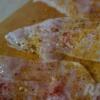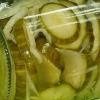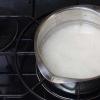What happens if you put an egg in vinegar? Amazing experiment with egg and vinegar
An ordinary chicken egg can glow, jump, and shed its shell! If you have any doubts about this, I hasten to dispel them...
What you will see now is a great idea for spending exciting leisure time with children and never-growing older people. Absolutely everyone will love this egg trick!
Egg in vinegar
You will need
- 1 egg
- glass tumbler
- vinegar
If you place a chicken egg in vinegar, an amazing chemical reaction will occur. The acids contained in vinegar and the calcium that is so abundant in eggshells are a magical mixture! Watch the video and see for yourself. I was amazed, especially in the last minute of watching...
I really liked it when the shell started to bubble - the vinegar did its job! This happens 5-6 hours after you place the egg in a glass of vinegar, keep this information in mind when you are about to conduct a fascinating experiment.
How extraordinary does such an elastic rubber egg look if you shine it with a flashlight... Definitely! If you are inspired by this idea and also decide to entertain someone like this, I will be very grateful to you!
Did you know that if you place an egg in vinegar for two days, the shell will dissolve and the egg will become elastic. Under the influence of vinegar, the calcium that makes up the shell dissolves and disappears in the form of gas bubbles.
The result is a funny egg that looks like jelly. If you experiment with a boiled egg, it will become elastic, like a rubber ball.
Pour table vinegar (9%) into a transparent glass and lower a chicken egg into it. Carbon dioxide immediately begins to be released from the surface of the egg.

Bird eggshells are made up of 90 percent calcium carbonate. Therefore, when interacting with acid, it begins to disintegrate, releasing CO2. 
After 12-15 hours we see what happened. Calcium from the surface of the egg has dissolved. Only the film between the shell and the egg remained intact. 
Remove the egg from the vinegar and rinse under running water. 
The egg increased slightly in size as it was saturated with vinegar. 
There is no shell and you can play with the egg like a ball. The film is very thin, and therefore can tear if handled carelessly. 
Now this rubber egg can be illuminated through. 




Attention: eating this egg is prohibited!
Did you know that if you place an egg in vinegar for two days, the shell will dissolve and the egg will become elastic. Under the influence of vinegar, the calcium that makes up the shell dissolves and disappears in the form of gas bubbles. The result is a funny egg that looks like jelly. If you experiment with a boiled egg, it will become elastic, like a rubber ball.
Pour table vinegar (9%) into a transparent glass and lower a chicken egg into it. Carbon dioxide immediately begins to be released from the surface of the egg.
Bird eggshells are made up of 90 percent calcium carbonate. Therefore, when interacting with acid, it begins to disintegrate, releasing CO2.
 After 12 - 15 hours we see what happened. Calcium from the surface of the egg has dissolved. Only the film between the shell and the egg remained intact.
After 12 - 15 hours we see what happened. Calcium from the surface of the egg has dissolved. Only the film between the shell and the egg remained intact.
 Remove the egg from the vinegar and rinse under running water.
Remove the egg from the vinegar and rinse under running water.
The egg increased slightly in size as it was saturated with vinegar.
 There is no shell and you can play with the egg like a ball. The film is very thin, and therefore can tear if handled carelessly.
There is no shell and you can play with the egg like a ball. The film is very thin, and therefore can tear if handled carelessly.
Now this rubber egg can be illuminated through. 
Attention: eating this egg is prohibited!
There are many amazing things in the world. Some of them you can do yourself at home.
Interesting experiments can be carried out with eggs.
You need to prepare the necessary materials, carefully read the instructions below, and be patient.
Experiment No. 1 - transparent rubber egg
For the experience you need:
- one raw egg;
- large cup or glass;
- 9% vinegar.
What to do.
- Place an egg in a cup.
- Pour in enough vinegar to completely cover the egg.
- Place the cup in a dark place for a day.
- After a day, remove the egg from the cup and clean it of the white coating that remains instead of the shell.
This is the simplest egg experiment. Let's complicate the task - let's make it glow!
VIDEO INSTRUCTION
What to prepare and how to make a glowing egg
For the experience you need to prepare:
- UV lamp;
- two glasses;
- two raw eggs;
- two markers of different colors;
- large bowl or medium sized bowl;
- vinegar 15%;
- gloves to protect hands;
- pliers.
What do we have to do.
- Wear gloves. Using pliers, remove the back cover of the marker. Remove the soft colored center.
- Pour 100 g of vinegar into a bowl or bowl. Place the center of the marker in vinegar and squeeze the paint out of it.
- Do the same with the second marker.
- Place the eggs in glasses and pour the prepared mixtures over them.
- Place the containers with eggs in a dark place for two days.
- After two days, remove the eggs and wash them thoroughly under running water. Pay attention! The prepared egg is several times larger than usual.
- Ready eggs look very beautiful under ultraviolet light. In addition, they are very elastic and bouncy. But you need to play with them carefully, because they can burst.
VIDEO DESCRIPTION
Scientific explanation of egg experiments
- Why does an egg become rubbery and where does the shell go?
The shell of an egg is made of a substance called calcium carbonate. Vinegar is an acid that can completely dissolve it.
The process that occurs when vinegar comes into contact with eggshells is called decalcification.
It takes at least 24 hours for the shells to dissolve.
- Why do eggs glow?
They are saturated with paint, which gradually penetrates them as the shell dissolves. The paint of the markers is very saturated, which is why it appears under the glow of an ultraviolet lamp.
Did you know that if you place an egg in vinegar for two days, the shell will dissolve and the egg will become elastic. Under the influence of vinegar, the calcium that makes up the shell dissolves and disappears in the form of gas bubbles. The result is a funny egg that looks like jelly. If you experiment with a boiled egg, it will become elastic, like a rubber ball.
(Total 12 photos + 1 video)
Post sponsor: Wedding photographer: Shooting from getting ready for the bride to cutting the cake, duration of work up to 9 hours. Making a photo book.

1. Pour table vinegar (9%) into a transparent glass and lower a chicken egg into it. Carbon dioxide immediately begins to be released from the surface of the egg.
2. The shell of bird eggs consists of 90 percent calcium carbonate. Therefore, when interacting with acid, it begins to disintegrate, releasing CO2.

3. After 12 - 15 hours, let’s see what happened. Calcium from the surface of the egg has dissolved. Only the film between the shell and the egg remained intact.

4. Remove the egg from the vinegar and rinse with running water.

5. The egg has increased slightly in size as it has been saturated with vinegar.

6. There is no shell and you can play with the egg like a ball. The film is very thin, and therefore can tear if handled carelessly.

7. Now this rubber egg can be illuminated through.





















